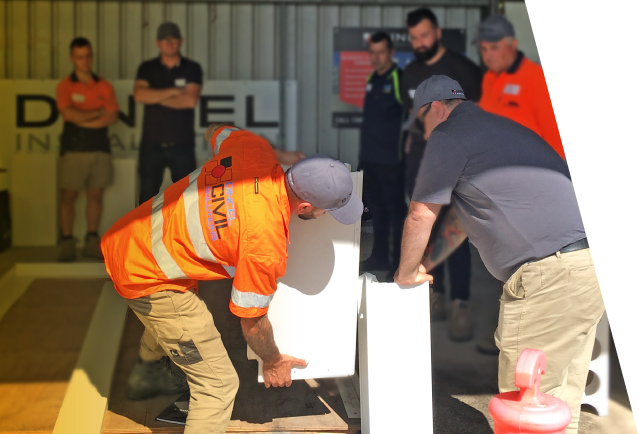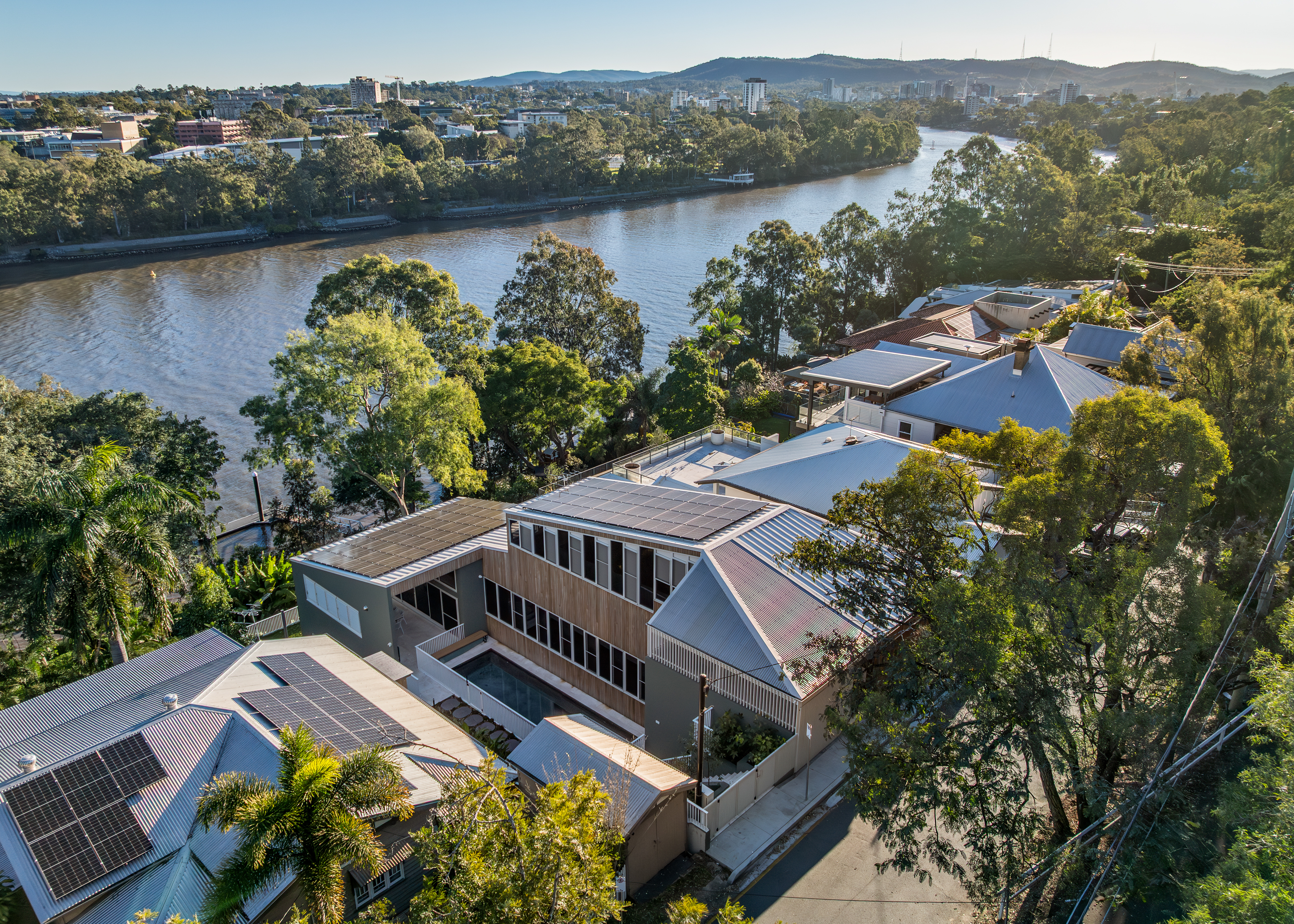Formworker Resources
-
Dincel Manuals & Guides
Download the latest Dincel Constructions Manuals and Installation Manuals to assist with your Dincel installation.
-
Brochures
Download the latest product brochures for Dincel Walling.
-
Compliance
The latest documents and information on Dincel compliance.
-
Tools & Fixing
Information for the recommended tools and fixings to use for Dincel installations.
-
Dincel Forms
Download the latest Dincel forms.
Formworker FAQs
Dincel Structural Walling is a permanent polymer formwork system for concrete walling. It can be used to construct a wide range of concrete walls: such as basement walls, intertenancy (party walls), core walls (lift and stair), retaining walls, façade walls, balustrades, columns, tanks, pools, sea walls, irrigation walls, curved walls, planter boxes and much more.
The polymer formwork stays in place after the concrete is poured (formwork is not stripped afterwards), thereby providing the wall with a waterproof and durable skin. This skin protects the concrete and steel reinforcement which increases the lifespan of the walls compared to conventional concrete and masonry structures.
Dincel hollow formwork panels are ‘snapped’ (clicked) together to build and form the wall. This patented snapping action ensures a safer, faster installation. While connecting panels, steel reinforcement can be added inside the wall as required. Once this is complete concrete is simply poured within the Dincel formwork.
The system comprises of accessories such as corners, caps, guides and joiners in order to streamline the installation process.
Dincel walls are available in 110mm, 155mm, 200mm and 275mm thicknesses. Widths per panel (module) is 333mm for the 110mm, 155mm and 200mm thick profiles, whereas the 275mm thick profile is square and has a width of 275mm. Panel length (height of wall) can be ordered from 1.8m to 7.95m for most profiles.
Wall dimensions do not need to exactly match Dincel standard panel widths, our profiles can simply be cut on-site to suit requirements.
- The formwork can be installed at an incredible rate of 25m² / 2 people / hour, even by non-skilled labour. This is attributed to the patented ‘snapping’ vertical connection of Dincel panels.
- No crane is required - each 3m long panel only weighs 13kg (for the 200mm profile).
- The ‘stay in place’ polymer formwork provides a permanent waterproof skin to the concrete wall, meaning a Dincel wall does not require further waterproofing other than to wall junctions (please refer to our waterproofing documentation for more information). This:
- Eliminates over excavation on the exterior side to basement perimeter walls (which is usually required for waterproofing purposes) – Build right up to the boundary and maximise land usage!
- Minimises the amount of the waterproofing products required and the labour to apply them.
- Minimises rectification works – the durable waterproof skin prevents corrosion of steel reinforcement and therefore minimises the risk of concrete spalling (concrete cancer).
- The system contains a unique crack inducing technology which:
- Reduces requirements for steel reinforcement within the wall – in some cases it can be eliminated completely. If steel reinforcement is required this can easily be inserted and held into place with the panel’s webs or accessories.
- Enables omission of vertical expansion joints for crack control - leading to reduced finishing and caulking requirements. However, Dincel recommends incorporating the joints of the suspended concrete slabs in the walls as well (please refer to your project structural engineer).
- Curved Dincel walls are easily achieved through the use of accessories.
-
Dincel creates on site synergies for formworkers and site crews:
- Profiles can be installed to be 1 metre above the deck height in order to act as edge protection, eliminating safety hand rails.
- Deck edge boards for floor slabs can be eliminated by simply removing the Dincel skin on one side only.
- Minimal bracing required.
- Installation of Dincel walls are not affected by wet weather conditions.
- Dincel 200mm profile incorporates built in service channels for easy accommodation of services.
Concrete in-filled block walls, conventionally formed in-situ concrete walls, precast/tilt-up walls, conventional brick walls, insulated concrete forms (ICF) and stay-in place forms consisting of fibre cement and metal sheet cladding.
Yes - Dincel is manufactured in Sydney, Australia. Supply is readily available for pickup or delivery Australia wide. For ordering:
- Place an order on our shop website or call (02) 9670 1633 to organise a meeting with a Dincel representative.
- Plans can be uploaded to the website in order for Dincel to prepare a detailed components list specific to your project.
No - Standard hand held tools are all that is required for most projects.
The base of the forms is restrained by a Dincel polymer guide (P-G), timber guides or angles, which also establishes the location of the walls. The top of the forms can be braced with either steel (push-pull prop) or timber bracing. Most of the bracing can be eliminated if there is a formworking deck above which the Dincel panels can be simply screwed into.
The unique design of Dincel formwork, as certified by the University of New South Wales, enables steel reinforcement to be eliminated for a wide variety of applications. However, if steel reinforcement is required, please see below installation methods:
Horizontal reinforcement - Central
- Simply feed reinforcement through the horizontal holes provided at 150mm spacing.
Horizontal reinforcement – Two layers
- 155mm & 200mm profiles:
- Use of the Dincel Horizontal Reo-Clip (HRC) accessory which can either clip or slide into the system and provides slots for two layers of bars, or
- The installer can simply fabricate hair-pin (‘U’) bars which are fed into the horizontal holes of the formwork.
- 275mm profile – Simply feed steel reinforcement into the two adjacent horizontal holes which are already provided as part of the profile.
Vertical reinforcement – Central or two layers
- Feed the steel reinforcement through the top of the Dincel formwork at the locations required. The bars can be held in place by:
- Weaving the vertical reinforcement in-between horizontal reinforcement, or
- By use of the Vertical Reo-Clip (VRC) accessory, or
- By tying to a support bar at the top.
No - Refer to the Concrete Mix Specification within the Dincel Construction Manual.
Yes - The system is designed to work best with a concrete pump, and the use of boom pumps is especially recommended. Concrete can also be placed with crane buckets, elevators or other typical placement methods.
No - The Dincel forms allow concrete placement at a nominal rate of approximately 1.5 vertical metres per hour (refer to concrete placement specification within the Dincel Construction Manual for exact requirements). The 275mm profile with its incredible strength allows for a single pour up to 4.5m!
Yes - We recommend a 25mm ‘pocket’ vibrator to be used by an experienced operator. Refer to the Dincel Construction Manual for more detail.
This depends on the circumstances. If a 50mm pump discharge pipe is used, superplasticisers are not recommended due to their limited working times. However, water reducers which don’t affect concrete working setting time may be used.
No - Provided the ends/corners of the walls are properly braced and the Dincel recommended method of installation is followed, it is almost impossible to have blow outs. Bulging of the forms can occur if a wet concrete mix is dropped into the forms from excessive heights or too fast. It is therefore recommended that the concrete pump discharge is directed to one of the internal webs of the Dincel profile to slow down the free fall of aggregate, avoid segregation and hydrostatic impact pressure. Refer to the Dincel Construction Manual for guidance.
No - This uplift phenomenon occurs with porous formwork surfaces such as fibre cement, masonry blocks or plywood sheets. Since cement slurry does not bond (no water absorption) to the polymer surface of Dincel forms, the formwork uplift which is normally experienced with common formworking systems does not occur with Dincel.
In addition, the round, horizontally aligned web holes of Dincel modules prevent the free fall of coarse aggregate, hence minimise concrete segregation. The same phenomenon, commonly called elephant-trunk action, pushes the forms down against the potential uplift caused by the wet concrete mix.
For the above reasons no physical connection is required between the bottom tracks/angles and the wall forms. However, in order to prevent the forms from being displaced by wind or accidental impact, it is recommended that the forms should be secured to the bottom tracks/angles.
Air voids are a known problem for formwork consisting of porous materials such as fibre cement, masonry blocks or plywood. Due to the water absorption of these materials, concrete adheres to the form face and this builds up on the surface causing air pockets. This does not occur with Dincel due to the impervious, frictionless polymer face which enhances concrete flow within the panel.
To ensure there are no air voids, the concrete must consist of a high degree of workability and flow to ensure that air voids do not occur. The use of Self-Compacting Concrete (SCC) has been tested with Dincel and is highly recommended. High-slump conventional concrete can also be used, however it must comply with the specification shown in section B.20 of the Dincel Construction Manual and must be vibrated adequately.
The system incorporates in-built crack inducers which act as shrinkage movement joints for the Dincel wall. Therefore, joints for standard crack control purposes are not required. However, building construction joints (joints in suspended slabs) may need to be carried through and incorporated into the Dincel wall as well.
Typically the day after pouring the in-situ foundations or slabs. This is confirmed by the project’s structural engineer and is dependent on concrete setting times and the building design.
Yes - This is a great advantage in terms of construction program, liability, safety, time and cost:
- The builder deals with one only trade who is responsible for walls, columns and floor slabs.
- The utilisation of floor slab formworkers increases the number of workers available for installation and increases construction speed.
- The formworkers utilise the slab deck for the installation and bracing of the wall forms, thus eliminating the need for additional bracing. This achieves safer, faster construction without the need to co-ordinate and schedule wall construction trades.
- Plumbing, electrical services and window installation can be carried out at any stage without interrupting the formworking trade. In this way, the formworker finishes the shell of the building without leaving the construction site.
Dincel walls can be finished in a wide variety of ways. Typically, the following finishes are applied:
- Internal finishes
- Plasterboard
- Paint
- Left raw as a clean off-white surface (typical for basements, fire stair escapes, lift shafts, etc)
- External Finishes
- Acrylic Render
- Paint
- Cladding (e.g. Stone, Timber, Tiles, Metal Cladding and Board Systems)
- Left raw as a clean off-white surface
No - Dincel panel joints control and minimise the contraction and expansion movements of the wall surface. Any differential movement between the Dincel skin and applied render finish is significantly reduced in comparison to conventional walls. The etching primer prepares the Dincel surface for chemical bonding. The polymer render base coat, being flexible enough, also absorbs any possible movement differential at the matching surfaces. In fact, this combination becomes much more reliable than the conventional cement render applied to masonry, concrete or fibre-cement surfaces. To view the companies who provide long term warranties that their render will not delaminate from the Dincel surface please see the Render Product Options
Conventional concrete walls crack due to the brittle nature of the material and the process typically starts while the concrete is still plastic. Unlike conventional concrete, Dincel provides an impermeable permanent skin which enables an ideal curing environment and subsequently allows the concrete to achieve additional strength and crack resistance performance. In addition to this, Dincel also provides internal crack inducers at approximately 125mm centres which cracks the concrete at controlled locations in order to act as expansion joints.
The presence of Dincel crack inducers distribute the contraction movements along the length of the wall and hence minimises the surface movement for the paint/render application. The paint/render used with Dincel should possess adequate elasticity to handle the maximum movement at each Dincel panel which is typically 0.8mm [(70-12) x 10-6 x 40°C x 333mm = 0.8mm]. Each Dincel panel joint has been designed to accommodate 1.5mm of movement. Therefore, the elasticity of the paint/render needs to be 0.8mm/1.5mm = 52% at 40°C variation. Special consideration needs to be taken for dark coloured renders where the wall surface temperature may increase significantly.
It is essential to check with the selected render manufacturer:
- The elasticity of the system and its suitability to span over panel joints.
- If sun-ray reflectors and polystyrene balls are used within the render to reduce temperatures (particularly with dark colours)
- Minimum render thickness required for insulation and crack control (typically 10mm)
- Joint spacing required for render (typically maximum 5m centres)
Further to this, a high amount of moisture inside the Dincel wall may lead to vapour trying to escape the system and cause cracks at Dincel vertical panel joints. In order to prevent this:
- Do not use a concrete mix with a water/cement ratio in excess of 0.5 or allow for water to be added to the concrete mix on site.
- Do not block/seal the top of Dincel Wall after concrete pouring. It should be remembered that Dincel is a waterproof container particularly after receiving polymer render or paint finish. Once the concrete has set the top can be adequately blocked/sealed to prevent external moisture (such as rain) from entering the wall.
The Dincel polymer formulation is based upon a proprietary and re-engineered uPVC. Some in the industry have concerns over the environmental sustainability of common PVCs because it contains plasticisers and heavy metal stabilisers during the manufacturing process. However, the Dincel polymer formulation does not use plasticisers or heavy metal stabilisers but rather organic stabilisers. This allows Dincel to be a certified non-toxic product and attain Best Environmental Practice (BEP) certification. Our unique polymer formulation also offers superior fire properties, smoke properties and UV resistance compared to common PVC. The Dincel polymer has been extensively tested and offers the following performance benefits and certifications:
Toxicity of smoke during a fire - 300% below the World Health Organisation (WHO) threshold. It is important to note that although smoke toxicity is not a DTS requirement within the Australian NCC/BCA, it has been tested with Dincel regardless.
Smoke quantity during a fire - 7 times less than the NCC threshold (based upon large scale AS ISO 9705 test)
Volatile organic compound (VOCs) - over 25 times better than the Australian Green Star threshold
Best Environmentally Practice (BEP) certified
Yes:
During Manufacturing
All manufacturing waste, including extrusion rejects, off-cuts and cored web holes are almost 100% recycled by Dincel’s superior manufacturing technology.
During Construction
Dincel provides custom profile lengths between 1800mm and 7950mm which significantly minimises the need for cutting and creating construction site wastage. Any Dincel product that cannot be used on site can be sent to third parties for recycling (the same standard practice as the PVC pipe industry).
End of Life
As Dincel can be designed to have reinforcement in the vertical direction only (or no reinforcement at all), it allows the recycling of vertical steel bars, concrete infill and Dincel’s polymer formwork at the end of building life with greater ease. The absence of steel bars in the secondary direction enables easy separation of steel bars from the concrete infill.



